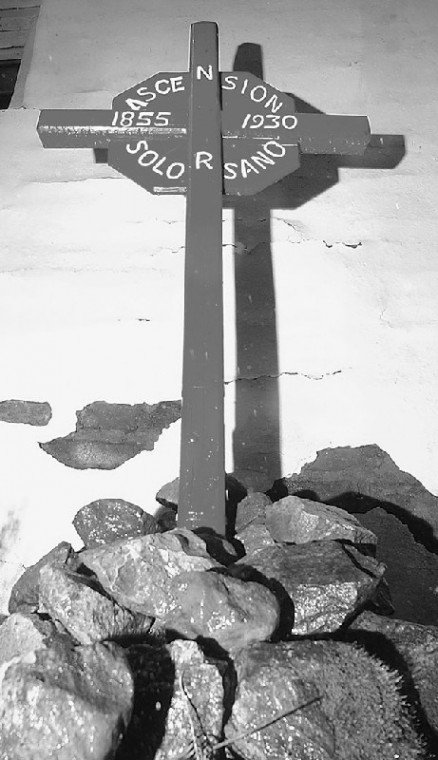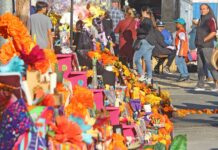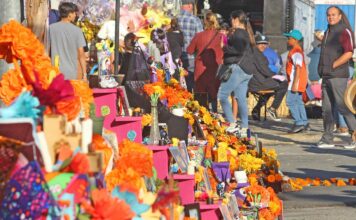It can take less than a century for a culture to all but vanish.
Historical records can be destroyed; a native language can
disappear; memories of tradition can be forgotten with the death of
elders. And a tribe’s federal recognition can be taken away more
quickly than it was granted.
It can take less than a century for a culture to all but vanish. Historical records can be destroyed; a native language can disappear; memories of tradition can be forgotten with the death of elders. And a tribe’s federal recognition can be taken away more quickly than it was granted.
Fortunately for the 600 or so Amah Mutsun Native Americans scattered around central California, it can take just a few dedicated descendants to revive a culture previously left for dead. It’s an enormous task, but Quirina Luna-Costillas, Valentin Lopez and several other Amah Mutsuns have taken it on. Together, they have spent years pushing for the reinstatement of the tribe’s federal recognition while piecing together the Amah Mutsun vocabulary, translating the traditional stories and learning the songs and dances that once made up the foundation of their tribe’s identity.
Rediscovering a long-forgotten language
“I always knew growing up that I was Indian,” Luna-Costillas said. “But sometimes you get people who say, ‘Well, if you’re Indian then speak your language.'”
But the tribe, indigenous to San Benito County, began to lose its language after 1797 when its members were forced to learn Spanish at the Mission San Juan Bautista. The Mutsun language officially died in 1930 with its last native speaker, Ascencion Solorsano, and Luna-Costillas never knew how to identify her heritage growing up.
“It’s hard to explain, but to speak your language… it’s just like a missing piece of myself,” she said. “It just makes me feel so much more whole as a person.”
Since 1997, Luna-Costillas and a few fellow Amah Mutsuns have been working to remedy the problem, to make life more complete for themselves and for their children, by resurrecting the dead language.
The trouble was, the language wasn’t just dead, it was hiding.
Latin is the most famous dead language, but it’s enjoying quite an afterlife. There are Latin-to-English dictionaries; volumes of Cicero with side-by-side translation; joke books filled with the Latin translation of idioms like “my dog ate my homework.”
But Mutsun is not dead like Latin is dead. Records of its vocabulary are fragmented and scattered, and nowhere near complete. Luna-Costillas has to comb through Mutsun-to-English phrase books written by missionaries and researchers over a century ago to find the translation for single words, one at a time, over and over again, hoping she’ll find what she’s looking for. Imagine looking in a Chinese dictionary for the Chinese word for “water.” Now imagine the only way to find the translation is to go through every known word in the Chinese language until you come across one with “water” written next to it in English. This is Luna-Costillas’ passion.
“It (the Mutsun language) just became something I was really fascinated in, and I began teaching it to my children,” said Luna-Costillas, who translated Dr. Seuss’ Green Eggs and Ham into Mutsun with a cousin in 2000. “I notice as my kids get older, they kind of lose their interest, but I use it as much as I can and I figure if they’re hearing it, when they’re ready they’ll speak it. My youngest child, Jonathan, there’s a couple of things he only knows how to say in Mutsun. His first word was Mutsun for ‘touch’ because I was always saying ‘don’t touch, don’t touch (in Mutsun).'”
Luna-Costillas also translated a traditional Mutsun story of how thunder, or “tura,” came about with the help of her sister in 1997. The story had been relayed in Spanish to Smithsonian Institute researcher J.P. Harrington by a tribal elder in the 1920s, Luna-Costillas said. It was later translated into English, and she and her sister painstakingly went through that translation word-by-word in 1997 to rewrite the tale in its native language.
And now that the Amah Mutsuns have Luna-Costillas working on translating their past, she’s already preparing for the future. Last year, she received a language grant that she used to put together a language committee. The five members of the committee decide what direction the language and the culture are going and plan accordingly, she said, coming up with new Mutsun phrases for words like “telephone,” for which they use the Mutsun words for “far-talker.”
Now, Luna-Costillas said, the language can even be written over e-mails by using the Spanish or Mexican phonetics system.
“We live in a modern world, you know?” Luna-Costillas said. “But I think we have a pretty good group to make the right cultural decisions.”
Uncovering a link to the past
Clues to a culture’s past can be found in the most unexpected places.
“You never know what could be under someone’s basement,” Luna-Costillas says. That’s been one thought running through her head since a high school student contacted the tribe saying he’d found some documents in his basement leading him to believe he might be related to Ascension Solorsano, the last full-blooded Amah Mutsun.
The document never materialized, but it taught the tribe to keep its eyes open. Luna-Costillas said she’s tracked down traces of the tribe’s traditional dances and music, which she said were borrowed by the Maidu and Miwok tribes. The Maidus and Miwoks she’s contacted have begun to teach her the dances, and she’s slowly getting the hang of it.
“Indians are really cautious. They have to be able to trust you, even though we’re all Indian. But we’ve developed a relationship with the Maidu where we trust each other, so they’re going to teach us some of the dances. Not step-by-step, but the understanding of how they are,” she said. “I’m starting to begin to understand when I hear the music. ‘OK, this is where this step would go on this beat.’ After a while you just start to get it.”
Tribal Chair Lopez said tribe members performed their traditional dances in public for the first time just a few months ago, and used their language in public for the first time in October of 2003.
“Those are big achievements for us,” Lopez said.
The tribe is also working with researchers at University of California at Davis and Berkeley, according to Lopez. The colleges are working with the Smithsonian Institute to get the notes of J.P. Harrington put into a data base. Harrington not only recorded the Mutsun language, but the stories, traditions, medical remedies and survival tactics of the Amah Mutsuns he met in San Benito County.
In 1922, Luna-Costillas said, Harrington came to San Benito County looking for her grandmother. But her grandmother was sick and had died by the time Harrington arrived. Other tribal members pointed him to Ascencion Solorsano, from whom he learned all about the Amah Mutsun culture, recording everything.
But when Harrington died in 1961, he left behind an estimated one million pages of notes from his various journeys. The Amah Mutsuns have been working with researchers at Davis and Berkeley to translate all of the notes Harrington took on their tribe – in Mutsun, Spanish, and English.
“It’s very hard to translate his work. You work for hours just to get one page done,” said Lopez. “But we are very lucky as a tribe in that much of our history and culture that appeared to be lost is in those notes.”
A tribe lost in history
The Amah Mutsuns “are not federally unrecognized,” according to Alan Leventhal, an associate professor of archaeology and anthropology at San Jose State University who has been working with the tribe since 1989. But the tribe has been stripped of the title thanks to hasty and questionable legislation changes and gross negligence on the part of government employees in the early 20th century, Leventhal said.
When California became a state in 1850, it was still largely populated – and technically entirely owned – by Native Americans. In 1851 and 1852, the United States Government drew up a series of 18 treaties asking the California Indians to give up rights to their some 78 million acres of land. For their sacrifice they would be rewarded with about 8.5 million acres of land in reservations throughout the state. But the treaties were never ratified, and Congress put a seal of secrecy on them shortly after they were drafted, Leventhal said, so California’s Native Americans never received legal ownership of the 8.5 million acres. And they couldn’t take the government to court because they were not US citizens and weren’t allowed to hire lawyers, Leventhal said.
In 1906, an act of congress made the Amah Mutsuns a federally recognized tribe, according to Leventhal. But in 1923 the United States government sent a man named Col. Lafayette Dorrington to California to determine which tribes were owed land by the government.
“Basically from 1923-1930, he completely neglected his duties,” Leventhal said, adding Dorrington was called back to Washington before he even visited the Amah Mutsuns in what is now San Benito County. “He finally responds (to Washington) with a report in 1927 and he lists by county all of the bands and tribes, and what he says for San Benito County is that there is one band of Indians called the San Juan Bautista band. And he says they do not need land because they have been well cared-for by the Catholic priests (at Mission San Juan Bautista).”
Valentin Lopez, the current chairman of the tribe, called Dorrington’s assessment “completely fraudulent.”
“Based on that, our recognition was dropped,” Lopez said.
In the late 1980s, the Muwekma tribe, which was federally recognized under the same criteria as the Amah Mutsuns around the same time and was later stripped of its recognition, began working with Leventhal to get their recognition back. The Amah Mutsuns heard about the collaboration and began working with Leventhal as well in 1989.
In the 1999, the Muwekmas sued the government for putting the tribe on a waiting list to be federally recognized once again. The waiting list normally takes about 25 years to get off of, Leventhal said.
The Muwekmas won the suit.
“Amah has tried to put together its documentation of previous recognition based on the success of the Muwekma, but the Bureau of Indian Affairs refuses to look at it. The only language the government understands is lawsuits, and those are very expensive,” Levanthal said. “The BIA is trying to eliminate previous recognition now. They want tribes to suffer for 25 years on their list. So the Amah Mutsun is not an unrecognized tribe, it is a recognized tribe that’s waiting to be put back on the list.”
Recent tribal developments
They have no plans to open a casino like other tribes throughout the state, but the Amah Mutsuns are involved in the other high-profile Indian development project in San Benito County: The inter-tribal dispute over plans for the development of the Sargent Ranch property. The Amah Mutsuns claim the 6,500-acre Sargent Ranch property as their ancestral land, of deep spiritual importance to the tribe members.
And currently, developer Wayne Pierce has plans to develop more than half of the property in Santa Clara County along with the tribe – or at least with part of it.
Pierce’s current plans are with a group of Amah Mutsuns led by Irenne Zwierlein, who would like to see the land developed to include Amah Mutsun and non-Native American housing and businesses and a cultural center.
But the other faction of the tribe, led by Lopez, fiercely opposes Zwierlein and Pierce’s plans, saying massive developments would disrupt the spiritual integrity of the land.
“It’s not like a particular thing that’s a monument, it’s the area. There are things there that aren’t supposed to be disturbed,” Luna-Costillas said. “For example, certain people in our tribe would have certain powers and would have respect in the community, and they would go to this certain hill where they lived and nobody would be able to go to that hill and speak to them. Even myself, even today, I wouldn’t go there because it’s not my place to be. It’s not about preserving that piece of land, it’s the air, it’s everything that’s there. That’s probably the most significant area to our tribe.”













